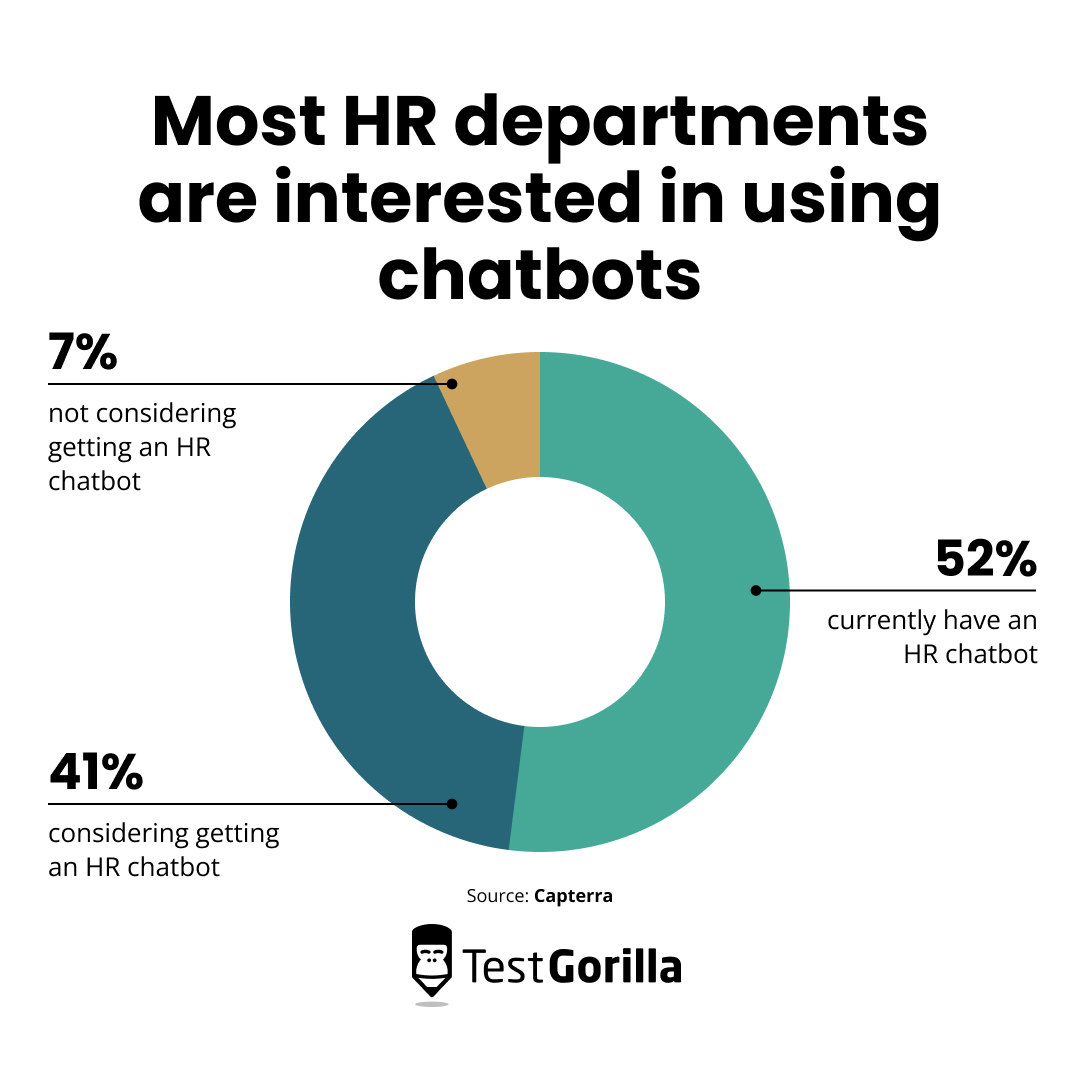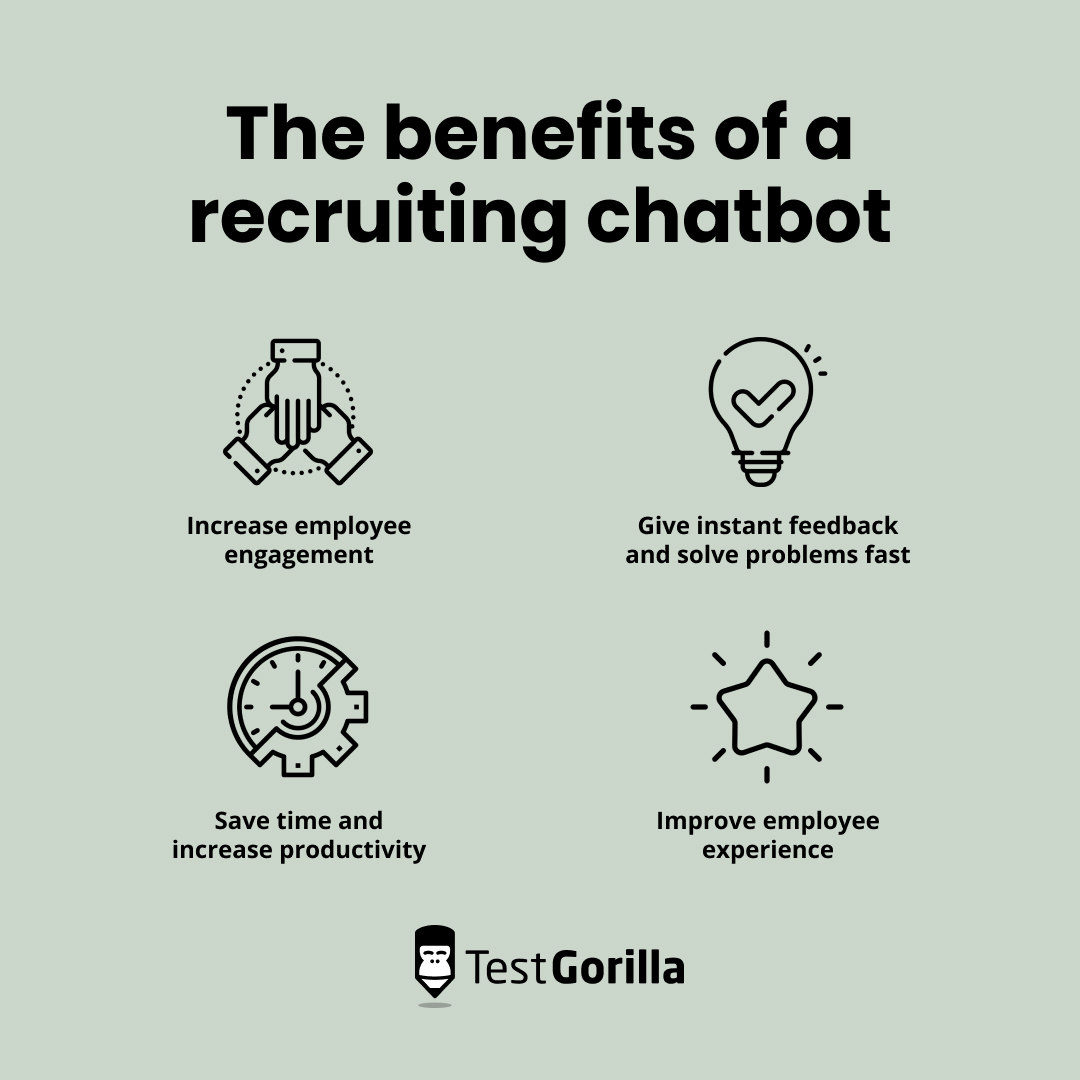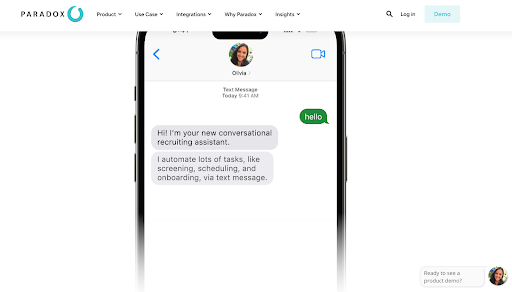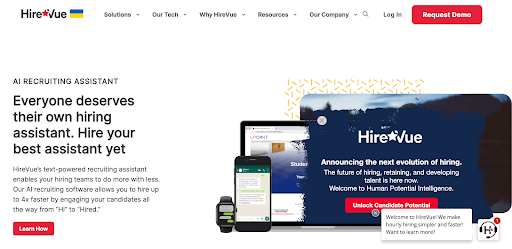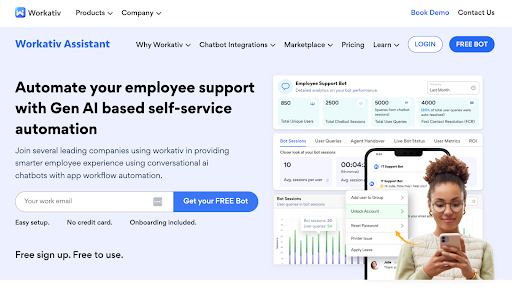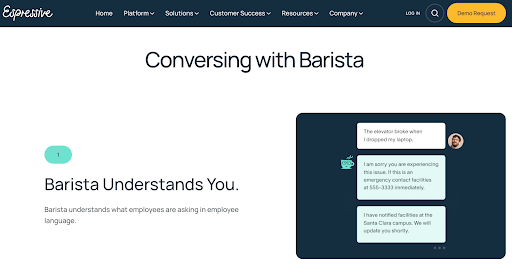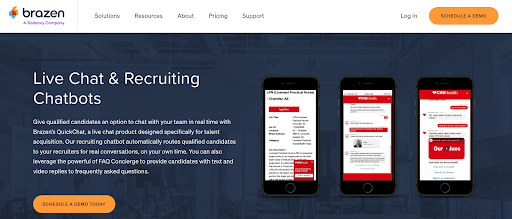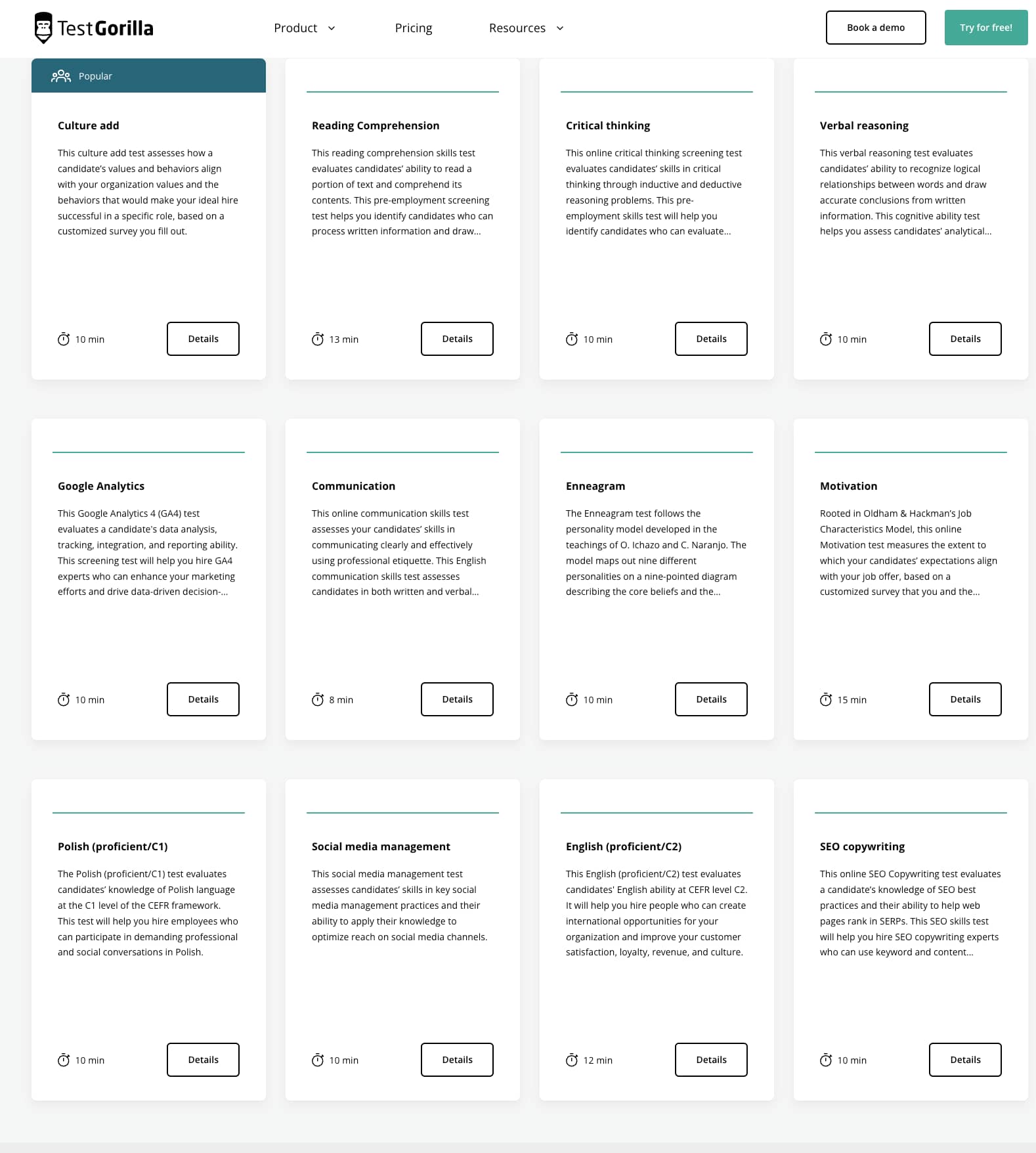Recruiting and managing your talent requires empathy and a nuanced understanding of the human experience – something robots don’t exactly excel at.
But what robots are good at is compiling data and automating repetitive tasks.
Research states that 36% of HR managers spend three to four hours daily on repetitive admin.[1] That's time that could be better spent on more meaningful tasks like candidate communication or onboarding recruits.
When balanced with a human touch, an HR chatbot can be a game changer for your HR team and skills-based hiring.
Used effectively, HR chatbots can help managers:
Support candidates during recruitment
Match employees to internal jobs with skills
Save time answering employee questions
Make onboarding processes more efficient and engaging
We’re just getting started – below, we show you why this HR technology is so important and how to use chatbots for the best.
Table of contents
- What is an HR chatbot?
- Why are HR chatbots important to HR professionals?
- The benefits of a recruiting chatbot
- 5 best HR chatbot tools
- 7 best practices for leveraging HR chatbots in your human resources department
- 3 examples of companies succeeding with recruitment chatbots
- Reach out and reduce your workload with HR chatbots
- HR and recruitment chatbot FAQs
What is an HR chatbot?
An HR chatbot is a virtual assistant that automates many of the most straightforward HR functions, such as scheduling interviews. It gives instant help to employees and recruits 24 hours a day, too.
HR chatbots use artificial intelligence, or AI, to read queries and data before giving relevant, automated responses.
The more you use automation, the more time you give back to your human recruiters to focus on high-value tasks. That way, you get more done with less labor and fewer people on the job.
That said, AI HR chatbots aren’t supposed to replace entire departments. You still need humans to handle complex HR processes like onboarding new hires, professional development, and tasks requiring empathy and critical thinking.
HR chatbot use cases: What can chatbots do?
A chatbot for HR departments can:
Answer employee questions
Help workers serve themselves, e.g., booking leave
Support candidates during recruitment, e.g., scheduling interviews
Answer queries and provide resources during new employee onboarding
Streamline requests and approvals
Connect team members
Give and manage feedback
Collect and analyze staff data
Offer 24-hour help
Help employees explore development opportunities
Give personalized answers to employees and candidates
Why are HR chatbots important to HR professionals?
Because of increasing administrative demand, companies are adding chatbots to their HR tech stacks to free up time and labor.
Without this HR automation tech, they’re stuck in admin cycles for half the working day. It’s time they could spend better communicating with and developing people.
As such, demand is growing for more “people-focused” processes. These processes are aimed to directly foster higher employee engagement – as stagnant levels of engagement cost the workforce an estimated $8.8tn.
Most HR departments are interested in using chatbots, too, with more than half already invested in the tech, according to Capterra:
Other research suggests that moving from manual to automated onboarding could boost productivity by 90%.[2]
When used as part of employee onboarding software, chatbots efficiently move people through recruitment funnels and give them more time to connect with others.
Moreover, HR chatbots are helping businesses acclimatize to flexible working. To go hybrid or fully remote, companies need to be as flexible and as digitally available as possible.
Without chatbots, remote workers might have to book physical meetings with HR. Instead, they can simply ask a chatbot a few questions from wherever they work, saving time and admin.
International workers benefit, too. Instead of waiting for HR opening hours outside their time zones, they can ask questions 24 hours a day and get instant answers.
This strategy helps HR teams promote remote working as a perk for distanced applicants.
Do HR chatbots offer good returns on investment?
The short answer is “yes” – but you need to measure ROI based on your running costs.
For example, assume the setup cost of your HR chatbot is $10,000, with monthly maintenance fees of $600. This is just a hypothetical example, as chatbot costs vary depending on the features you choose.
An employee’s salary spent chatting each day could cost $100. That means it costs roughly $2,500 across 25 working days a month.
That’s an immediate saving of $1,900 per worker after initial costs. However, remember that just one chatbot for HR services could take on several workloads.
The benefits of a recruiting chatbot
Used effectively, an AI chatbot for recruitment can:
Increase employee engagement
Give instant feedback and solve problems fast
Save time and increase productivity
Improve the employee experience
Let’s explore these points in more detail.
1. Increase employee engagement
Chatbots for HR increase employee engagement by answering questions on demand. They act as knowledge bases people can use as self-service support.
Recruiting chatbots engage with candidates by providing useful resources, answering questions, managing paperwork, and setting up connections.
What’s more, chatbots encourage employees to reach out because they offer quick, easy ways to find answers.
Oracle claims that 64% of employees trust chatbots more than their managers, meaning they’re more likely to chat to AI first.
2. Give instant feedback and solve problems fast
Employees get instant answers from chatbots instead of waiting around for human support. The answers they get are concise and objectively correct, and there's no risk of bias or human error.
There is, however, always a need for human support. You can’t, say, rely on a chatbot to understand specific lifestyle or time off needs.
Chatbots send information from conversations to employees, making previous discussions easier to manage through HRIS systems.
3. Save time and increase productivity
According to Adam Godson, the president and chief procurement officer of AI platform Paradox, between 50% and 80% of HR duties that involve answering questions can be handled with automation.[3]
The shift to automation is already improving many companies’ HR operations and services, saving them precious time. In fact, research shows that time saved by using machine learning in HR could increase overall department productivity by up to 72%.[4]
Tesco, for example, uses the chatbot “Tess” to answer more than 150 common questions and direct employees to relevant policies and learning material.[5]
If a user asks something out of the ordinary, the chatbot “fails gracefully,” meaning that if it can’t find the answer, it redirects the employee to a different support channel and remembers the interaction.
This helps the company spot repeating questions and train Tess to answer them, ensuring constant improvement of its service and a better employee experience.
4. Improve employee experience
With a chatbot, you guarantee everyone has access to self-service at any given time, so they don't have to wait for the correct office hours or accidentally break company policies.
Employee satisfaction improves, too. Recruits don’t have to send emails back and forth regarding the same questions because HR chatbots take them through each step of the process.
Moreover, AI-powered chatbots help to streamline the service HR offers to staff. They can explain complex policies, book time off, and produce learning material.
This on-demand service builds a better employee experience because your workers don’t have to struggle to find the resources they need.
5 best HR chatbot tools
Let's look at some of the best chatbot tools for lightening your HR workload.
Factors we considered
When researching the best HR chatbot programs, we considered the following points to compare:
Ease of use
Automation potential and scale
Pricing and value
Human effort required
Customization
Conversational features and intelligence
Integration, e.g., with HR analytics software
Five of the best HR chatbots worth investing in
Tool | HR chatbot benefits |
1. Paradox.ai | - Onboarding management - Full dashboard - Integrates with leading applicant management software |
2. HireVue | - Automated pipeline updates - Matches roles to passive recruits - Encourages applicants to book and attend interviews |
3. Workativ | - Free bot setup and trial - Hundreds of workflow automation templates - Connects with top software such as Slack and Office 365 |
4. Espressive Barista | - Employee wellness management - Understands billions of phrases - Up to 100 languages supported |
5. Brazen QuickChat and FAQ Concierge | - Video response function - Virtual job fair integration - Chat via SMS |
1. Paradox.ai: Best for candidate experience
Paradox.ai’s chatbot, Olivia, is a multilingual recruitment assistant.
Built with candidate experience in mind, this conversational AI tool schedules interviews, gives insights into company culture, and updates applicants.
Olivia is highly customizable. Its other employer benefits include built-in screening, onboarding management, and integrations with popular software such as Workday.
The company’s support team is highly rated, as is its dashboard’s ease of use and speed of contact with applicants.
Pros | Cons |
- Highly intelligent conversation system - Easy to acclimatize to - Integrates widely - Updates applicants on your behalf - Purpose-built as employee onboarding software
| - Pricing only available on request - Some users have concerns over integration support |
Rating: 4.7 out of five, 39 reviews (G2)
Pricing as of December 2023: Available on request
2. HireVue: Best for efficient recruitment
Like Paradox.ai, HireVue is software focusing on better hiring, with its AI recruiting assistant being one of several HR tools it supplies.
This software engages with candidates to help them move efficiently along the pipeline, automatically guiding them through your applicant tracking system.
The company claims it can speed up time-to-interview by up to five times and boost candidate satisfaction by 32%.
Pros | Cons |
- Integrates easily with applicant tracking - Offers 24/7 support to candidates - Provably reduces interview ghosting - Removes the need for manual follow-up - Matches open roles to candidates during passive recruiting | - Not user-friendly as other tools on our list - Pricing typically includes the full product range |
Rating: 4.1 out of five, 231 reviews (G2)
Pricing as of December 2023: From $35,000 – includes full HireVue range
3. Workativ: Best for integrations
Workativ is an off-the-shelf HR and recruiting chatbot that arrives with several built-in HR app integrations.
Its no-code setup makes it easy to navigate and connect automatically with popular HR management brands such as Gusto, BambooHR, and Slack.
The service’s user-friendly interface lets you create and edit form responses to common questions, and actions bots take on more specific concerns, such as providing contact details or resetting passwords.
Its integration-friendly approach lets you slide it easily alongside a central CRM, payroll software, and benefits trackers.
Pros | Cons |
- Integrates with scores of different software brands - It’s free to set up and try a bot - Easy to create and edit forms and specific responses in “Try Me” mode - No coding knowledge required - Works seamlessly alongside other HR dashboard and management software | - Some users claim there are integration limitations |
Rating: 4.2 out of five, 2 reviews (G2), 4.3 out of five, 3 reviews (Capterra)
Pricing as of December 2023: From free
4. Espressive Barista: Best lifecycle coverage
Espressive’s Barista AI assistant offers complete worker lifecycle management, covering recruitment, onboarding, performance, benefits, and employee wellness.
If it doesn’t understand the question an employee is asking, rather than giving potentially incorrect answers, this chatbot asks follow-up questions to provide more specific help.
It offers AI-based employee surveys, where users can answer questions that trigger real-time actions. For example, the chatbot can set up workflows to change timetables if a user says they can’t work weekends.
Pros | Cons |
- Multilingual in 100 languages - Supports employees from recruiting through offboarding - Designed to make work efficient for workers and HR - Helps to support employee wellness platforms - Integrates with popular HR software such as Workday | - Some users claim its reporting and analytics features aren’t user-friendly |
Rating: 4.9 out of five, 15 reviews (G2)
Pricing as of December 2023: Available on request
5. Brazen QuickChat and FAQ Concierge: Best for job fair integration
Brazen's QuickChat and FAQ Concierge has earned a spot on our list primarily thanks to its ease of use and impressive video response functionality. This function lets you send personalized footage to specific questions, enhancing the employee experience.
The manufacturer's main focus is supporting hiring during virtual job fairs and physical events. Using its AI, you can "quick chat" with high-value candidates attending fairs using its prescreening features.
The product also arrives with a recruiter dashboard that collects interaction data to build candidate profiles.
Pros | Cons |
- Video response functionality - Detailed data analytics - Prioritizes the best candidate matches - SMS functionality - Pushes data to external recruiting platforms | - Little pricing transparency - Not as customizable as other tools |
Rating: 4.6 out of five, 159 reviews (Capterra)
Pricing as of December 2023: Available on request
7 best practices for leveraging HR chatbots in your human resources department
Before getting started with a recruitment chatbot and instant messaging for the first time, take a look at our seven top tips for making the most of your new tech.
Most effective ways to use your HR and recruitment chatbot
Best practice | In brief |
1. Start small and scale up | Test your chatbot carefully to learn how it works, track metrics, and gauge employee feedback |
2. Determine your organization’s goals | Be clear on what you want chatbots to achieve and measure its return on investment over time |
3. Work with legal experts | Get legal advice to keep compliant with data protection and avoid harmful bias against employees |
4. Check your chatbot aligns with your culture | Train your recruitment chatbot on who you are and what it's like to work for you, using video where possible to encourage applicants to follow through |
5. Prioritize chatbots during recruitment | Train chatbots on a knowledge base to support applicants' questions and on skill tests to help inform your hiring decisions |
6. Use chatbots to manage performance | Design chatbots to answer workers’ questions about development and use the data pulled to track their progression |
7. Don’t replace HR – supplement it | Always check chatbots' accuracy and performance with employees and recruits; don't assume AI can replace HR staff outright |
1. Start small and scale up
Start small and slow with your HR chatbot to test its functions and ensure you understand how to use it.
Beta test your chatbot by rolling it out across a specific department first and getting employee feedback. Ask staff if they found it easy to use, if it answered their questions, and if they have any suggestions for improving it.
Track metrics such as how much time you save on specific HR tasks, how many people actually used the service, and how effectively it pulls useful applicant data.
2. Determine your organization’s goals
Don't invest in a recruitment chatbot unless you have clear goals it can help you meet. For instance, you might need to invest in an HR chatbot to:
Reduce applicant ghosting by improving their experience
Free up HR personnel time from admin duties
Reduce turnover costs by improving staff engagement
AI is a hot HR technology trend right now, but investing in it for the sake of doing so is a waste of time, money, and resources.
For example, if you run a small company and have the personnel available to engage properly with your people, a chatbot might not be a wise investment right now.
That said, consider other benefits HR chatbots can bring to your firm, such as 24-hour support for remote and international workers.
Work with your staff, management, and directors to plan for when and how to roll out HR chatbots.
Lastly, keep an open mind. The software you choose now might not work out as you expect it to, so look for free trials and research the market to find the chatbot that best suits your needs.
3. Work with legal experts
While planning and beta testing, carefully consider the legal ramifications of using chatbots. We advise you to do so with your in-house legal department or with trusted experts externally.
Chatbots also run the risk of training on prejudiced or incomplete data, leading to bias in their logic.
There’s also data protection to consider. Chatbots in recruitment frequently pull candidate and employee data and use it to build profiles and personalize services.
To comply with European and Californian data legislation, for example, you need to explain which data you collect and how you intend to use it.
Laws regarding AI and chatbots in different industry applications are under discussion. For instance, bodies as large as the European Union are restricting the use of AI in auditing.[6]
For extra protection, use software compliant with your state’s data legislation.
Disclaimer: The information contained in this site is provided for informational purposes only and should not be construed as legal advice on any subject matter. If you have any questions on HR chatbots in your area, please consult with a lawyer.
4. Check your chatbot aligns with your culture
Your chatbot represents your culture and your policies. So, ensure it aligns with what you believe in and what you want to show to candidates and employees.
Roughly 67% of people feel misled regarding company culture during recruitment. Adjust your chatbot to offer an accurate and transparent look into your workplace.[7]
Start by training your chatbot on a knowledge base built on your policies and processes. Consider using software such as Paradox.ai’s Olivia, which shares videos and team testimonials to show what it’s like to work for you.
Test your software on a group of control users, acting as potential recruits, before pushing it live.
5. Prioritize chatbots during recruitment
Use an HR helpdesk chatbot to act as your applicants’ personal concierge. Choose software such as HireVue, built for recruitment, to keep the process efficient while personalizing conversations.
Use a chatbot to act on your behalf to keep applicants informed on where they are in the recruitment process. Save them from having to chase for updates.
Create a database of answers to popular questions and use it to train your bot. For instance, you could create answers to common questions such as:
When is my job interview?
What is the email address for my recruiter?
Can I see my contract?
How many hours do I need to work?
Can I speak to a human?
Then, use your chatbot to pull data from applicants to help personalize their onboarding experience.
Use chatbots to screen and test candidates, potentially matching them to roles based on assessment scoring.
Always optimize for a skills-based recruitment experience and show candidates that you value their talents rather than their experience.
Use chatbots that let you insert talent assessments into conversation flows. Then, pull the data to create a clearer picture of who you aim to hire.
You could set up a series of skills tests for a graphic designer role that triggers based on a job keyword.
6. Use chatbots to manage performance
Consider using chatbots to help employees upskill and reskill while looking for new opportunities within your company.
For example, a marketing professional might want to join your SEO team. By asking a chatbot for information, your bot could offer a series of tests they can complete that tie in with roles in the team.
Here's what TestGorilla recommends for an SEO copywriter assessment, for instance:
HR might then pull test scores and store them for future lateral moves across the company. They could arrange people who score highest and add details to professional development plans.
This strategy helps you make learning and development part of employee self-service. They can explore career development opportunities in their own time, track scores, and check in with HR to check progress.
Doing so saves HR time and gives more control to employees. They’re free to explore opportunities and develop themselves with chatbots.
7. Don’t replace HR – supplement it
Chatbots can’t take responsibility for making final hiring decisions. They can’t show empathy to workers during difficult circumstances or understand complex training needs.
Without human interaction, you risk alienating and frustrating employees, regardless of a chatbot’s usefulness.
Looking back at the Capterra study linked earlier, at least 33% of their surveyed workers feel the chatbots they use at work are accurate. Only 40% trust them to process requests properly.
There's always a need for humans to check the accuracy and effectiveness of chatbots, e.g., in the name of legal compliance, potential bias, and reputational effects.
3 examples of companies succeeding with recruitment chatbots
Many companies are using recruiting chatbot technology to relieve HR strain.
Here are three examples of HR chatbots hard at work in the real world to inspire your own processes
UOB
Setting up a recruitment chatbot helped United Overseas Bank (UOB) transform its HR department so much that it won an Excellence in Recruitment award in 2019.
This is a company charged with recruiting hundreds of sales positions, amounting to 5,000 applications and 1,000 scheduled calls each year. The need for automation was apparent.
UOB used a chatbot to replace a long application form with a quick-apply form on WhatsApp in multiple languages. The bot then automatically follows up with candidates to schedule interviews with those who pass the initial qualifications. Finally, it sends an intent-to-offer to those who passed their interviews.
Using HR chatbots helped UOB reduce time-to-hire by half, boost offer acceptance rates by 15%, and resonate positively with 96% of candidates.[8]
NHS Trust
The East and North Hertfordshire NHS Trust, a medical body in the UK, used an AI HR chatbot based on IBM’s Watson model to handle thousands of employees’ questions.[9]
With 24-hour access, healthcare employees can access useful information and natural language processing during critical moments. The healthcare industry demands fast response times from staff and systems, and this chatbot is always on hand during emergencies.
This chatbot is also continuously learning – it records any questions that it was not able to answer, which can then be added to its database in further updates. This way, it can keep on top of things in the ever-evolving environment of healthcare.
Jacques Raud Consulting
Jacques Raud, an IT recruitment consultancy, moved toward an HR chatbot system to boost website applications and engage more with candidates.
Using chatbots, the company created a personalized AI experience that enables users to choose specific conversation paths. This helped the business to filter through recruiters and job applicants.
The bot's workflows help users upload resumes and take details for return calls, keeping them updated on what happens next.
The bot also uses images and emojis to add a more human touch to reduce the sensation of "talking to a robot."
Using chatbots has helped the consultancy to increase applications by 130% within a few months of setup.[10]
Reach out and reduce your workload with HR chatbots
Robots only seem scary if you think of them in the context of replacing humans.
However, the goal of HR chatbots is to enhance the value of your HR service, not remove your human reps from the picture.
Used strategically, an HR chatbot can:
Improve your HR leaders’ lives by taking over repetitive tasks
Provide consistent service and instant answers to help employees
Save you money in the process
The best chatbots for recruiting can also help you build a skills-first workforce by filtering applicants, walking them through skills assessments, giving them personalized updates, and even onboarding them.
If you want to move toward a skills-centered workplace, follow up this guide by reading more about using talent assessment software.
From there, we recommend learning more about employee experience software with help from our deep dive.
When you’re ready to start assessing skills through a chatbot, head to the TestGorilla library to choose your first tests.
HR and recruitment chatbot FAQs
Here are some final questions and answers to help introduce you to HR chatbots.
What is an HR chatbot?
An HR chatbot is an artificial intelligence or AI program that holds conversations with employees and job applicants. HR bots help people learn more about company policies, book time off, and book interviews.
Do recruiters use bots?
Yes. Recruiters use chatbots to help answer candidate questions, offer skills tests to judge role suitability, and give updates on application progress.
How can chatbots improve the employee experience?
HR chatbots offer employees self-service tools to manage their learning and development, staff benefits, and answer questions without waiting for an agent to respond.
Sources
1. “Companies are Overlooking a Primary Area for Growth and Efficiency: Their Managers”. (March 2018). West Monroe. Retrieved December 11, 2023. https://www.westmonroe.com/perspectives/report/companies-are-overlooking-a-primary-area-for-growth-and-efficiency-their-managers
2. White, Trevor. (December 2018). “Guidebook Zenefits”. Nucleus Research. Retrieved December 11, 2023. https://learn.zenefits.com/rs/180-GFH-982/images/nuceleus-guidebook-zenefits.pdf
3. Blum, Sam. (March 6, 2023). “Could chatbots help HR evolve into a more strategic business function?”. HR Brew. Retrieved December 11, 2023. https://www.hr-brew.com/stories/2023/03/06/will-chatbots-help-hr-evolve-into-a-more-strategic-business-function
4. Benoit, Marie-Claude. (November 10, 2022). “According to a report from Genius Consultants, 68% of companies believe AI in HR increases overall work accuracy”. Actuia. Retrieved December 11, 2023. https://www.actuia.com/english/according-to-a-report-from-genius-consultants-68-of-companies-believe-ai-in-hr-increases-overall-work-accuracy/
5. “Tesco: Tess Bot”. EBM. Retrieved December 11, 2023. https://ebm.ai/tesco/
6. Moreno, J. Edward. (March 29, 2023). “AI Chatbot ‘Gold Rush’ Generates New Workplace Legal Pitfalls”. Bloomberg Law. Retrieved December 11, 2023. https://news.bloomberglaw.com/daily-labor-report/ai-chatbot-gold-rush-generates-new-workplace-legal-pitfalls
7. “Professionals report leaving a job due to poor cultural fit”. Robert Walters. Retrieved December 11, 2023. https://www.robertwalters.co.uk/insights/hiring-advice/blog/Professionals-have-left-a-job-due-to-poor-cultural-fit.html
8. “50% reduction in time to hire with conversational AI”. Paradox. Retrieved December 11, 2023. https://www.paradox.ai/case-studies/uob
9. “East and North Hertfordshire NHS Trust Launches New Virtual Assistant with IBM Watson to Support Human Resources and Bolster Employee Services”. (November 28, 2022). IBM. Retrieved December 11, 2023. https://uk.newsroom.ibm.com/2022-11-28-East-and-North-Hertfordshire-NHS-Trust-Launches-New-Virtual-Assistant-with-IBM-Watson-to-Support-Human-Resources-and-Bolster-Employee-Services
10. Franceschi, Camille. (August 8, 2019). “How Jacques Raud Consulting has more than doubled its number of applications”. Joonbot. https://joonbot.com/blog/case-studies/jacques-raud-consulting-feedback/
Related posts
Hire the best candidates with TestGorilla
Create pre-employment assessments in minutes to screen candidates, save time, and hire the best talent.
Latest posts
The best advice in pre-employment testing, in your inbox.
No spam. Unsubscribe at any time.

Hire the best. No bias. No stress.
Our screening tests identify the best candidates and make your hiring decisions faster, easier, and bias-free.
Free resources
This checklist covers key features you should look for when choosing a skills testing platform
This resource will help you develop an onboarding checklist for new hires.
How to assess your candidates' attention to detail.
Learn how to get human resources certified through HRCI or SHRM.
Learn how you can improve the level of talent at your company.
Learn how CapitalT reduced hiring bias with online skills assessments.
Learn how to make the resume process more efficient and more effective.
Improve your hiring strategy with these 7 critical recruitment metrics.
Learn how Sukhi decreased time spent reviewing resumes by 83%!
Hire more efficiently with these hacks that 99% of recruiters aren't using.
Make a business case for diversity and inclusion initiatives with this data.

